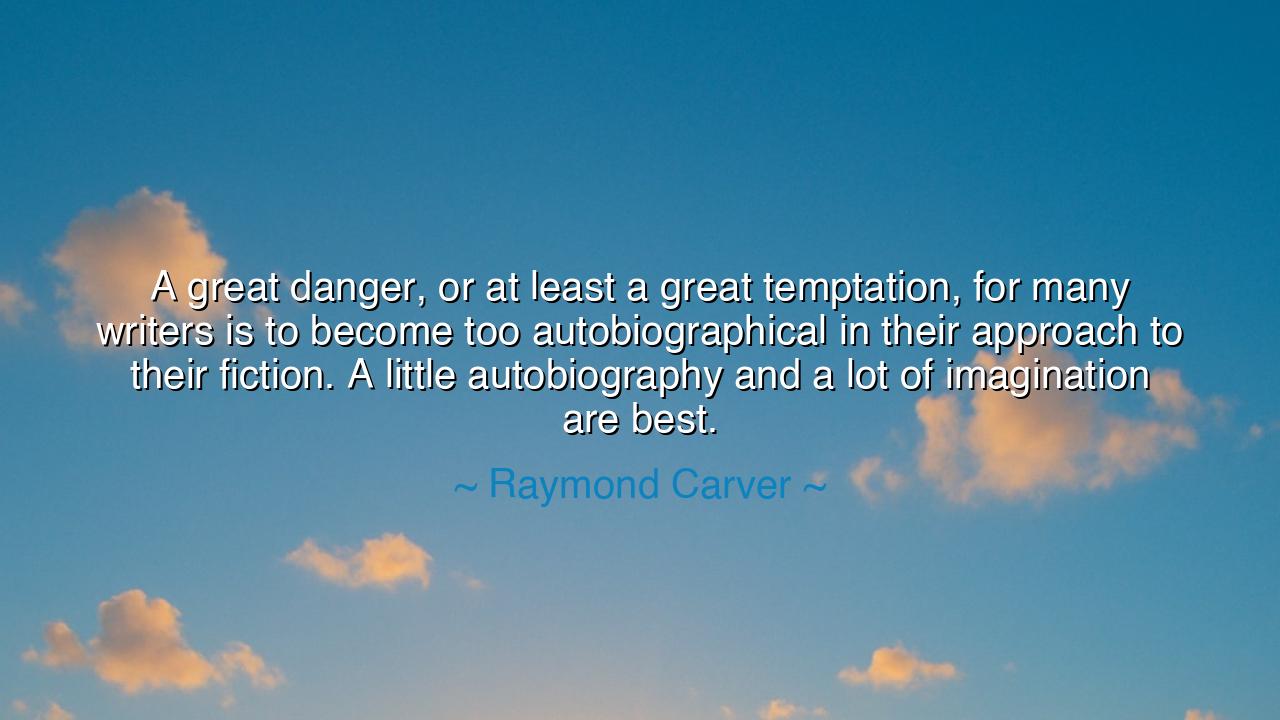
A great danger, or at least a great temptation, for many writers
A great danger, or at least a great temptation, for many writers is to become too autobiographical in their approach to their fiction. A little autobiography and a lot of imagination are best.






When Raymond Carver warned, “A great danger, or at least a great temptation, for many writers is to become too autobiographical in their approach to their fiction. A little autobiography and a lot of imagination are best,” he spoke not only as a craftsman of words, but as a guardian of the sacred art of storytelling. His message is not merely a technical rule for writers—it is a timeless teaching about balance, about the delicate harmony between experience and imagination, between what is lived and what is dreamed. For if the writer becomes bound by the chains of his own life, his work ceases to soar; and if he abandons truth entirely, his stories lose their heartbeat.
Carver, who was himself a man of great hardship and humility, knew this danger well. His stories often glimmered with the pain and quiet heroism of everyday life, yet he never surrendered entirely to autobiography. He understood that to write only from one’s own wounds is to remain a prisoner of them. True art requires the courage to transcend the self, to take what is personal and transform it into something universal. Thus, when he speaks of “a little autobiography,” he means that our experiences are the seeds—but it is imagination that allows those seeds to grow into forests of meaning that others can enter and call their own.
This idea has echoed through the ages. Even the ancients understood that the poet must walk the line between memory and myth. Consider Homer, whose tales of Troy and Odysseus were surely rooted in fragments of truth—the echoes of battles fought, heroes remembered—but were lifted beyond the mortal by the power of imagination. He took what might have been mere history and turned it into eternal song. So too did Carver suggest that the writer’s task is not to recount, but to reimagine; not to confess, but to create. A life faithfully transcribed is mere recollection, but a life transformed by vision becomes art.
Yet Carver’s warning reaches beyond writers alone—it speaks to all who live. For every person, in some measure, is an author of their own existence. There is always the temptation to define oneself only by one’s past—to be trapped in the story already lived, unable to imagine another ending. But the wise soul knows that imagination is the power of renewal, the flame that allows us to reshape the narrative of our lives. Just as the writer must not be enslaved by autobiography, so must each of us learn to rise above our history and envision a future that is not dictated by it.
The story of Virginia Woolf offers a profound example. Her life was shadowed by sorrow and inner turmoil, yet she refused to be defined by it. Through the prism of imagination, she transformed her pain into radiant works such as Mrs. Dalloway and To the Lighthouse. Her fiction was not pure confession, but a symphony of feeling—her life transmuted into beauty. In her art, her autobiography was not erased, but transcended; it became the raw clay from which she sculpted timeless truth. This is the mastery Carver speaks of: the ability to turn one’s life into language, and one’s language into a mirror for all of humanity.
But Carver also reminds us that too much of the self can be a form of vanity—a narrowing of the lens through which we see the world. The writer who stares only at his own reflection may forget the faces of others. Imagination, then, is an act of empathy, the bridge that carries us beyond our own hearts into the hearts of strangers. To imagine is to love widely, to see the world not only through our eyes but through the eyes of those who are different from us. When a writer dares to imagine another’s pain, another’s joy, another’s dream, he becomes a vessel of truth larger than his own experience.
So let this be the lesson, not only for writers, but for all who seek to live with depth and wisdom: do not drown in your own story. Use your memories as the soil, but let imagination be the sunlight that helps them grow. Reflect on your life, yes—but let it serve as a bridge to something greater, not as a cage. Practice seeing the world through others’ eyes, for only then will your heart and your art expand.
For, as Raymond Carver teaches, “a little autobiography and a lot of imagination” is the formula not just for good fiction, but for a life well-lived. To dwell too much within the self is to stagnate; to imagine beyond it is to evolve. The stories we tell—whether with pen or action—are not meant to be mirrors alone, but windows through which light enters. And it is through that light, born of imagination, that we and our creations become truly alive.






AAdministratorAdministrator
Welcome, honored guests. Please leave a comment, we will respond soon